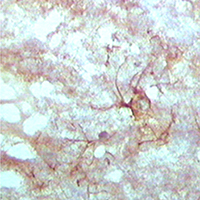PDTC ameliorates neuropathic pain by inhibiting microglial activation via blockage of the TNFα-CX3CR1 pathway

Submitted: 30 September 2020
Accepted: 18 January 2021
Published: 12 March 2021
Accepted: 18 January 2021
Abstract Views: 1067
PDF: 658
HTML: 8
HTML: 8
Publisher's note
All claims expressed in this article are solely those of the authors and do not necessarily represent those of their affiliated organizations, or those of the publisher, the editors and the reviewers. Any product that may be evaluated in this article or claim that may be made by its manufacturer is not guaranteed or endorsed by the publisher.
All claims expressed in this article are solely those of the authors and do not necessarily represent those of their affiliated organizations, or those of the publisher, the editors and the reviewers. Any product that may be evaluated in this article or claim that may be made by its manufacturer is not guaranteed or endorsed by the publisher.
Similar Articles
- W. Theunissen, D. Fanni, S. Nemolato, E. Di Felice, T. Cabras, C. Gerosa, P. Van Eyken, I. Messana, M. Castagnola, G. Faa, Thymosin beta 4 and thymosin beta 10 expression in hepatocellular carcinoma , European Journal of Histochemistry: Vol. 58 No. 1 (2014)
- Lan Wang, Zhenyu Fan, Haijin Wang, Shougui Xiang, Propofol alleviates M1 polarization and neuroinflammation of microglia in a subarachnoid hemorrhage model in vitro, by targeting the miR-140-5p/TREM-1/NF-κB signaling axis , European Journal of Histochemistry: Vol. 68 No. 3 (2024)
- Rong Tian, Gengsheng Mao, Ghrelin reduces cerebral ischemic injury in rats by reducing M1 microglia/macrophages , European Journal of Histochemistry: Vol. 66 No. 1 (2022)
- J. Ning, J. Zhang, W. Liu, Y. Lang, Y. Xue, S. Xu, Overexpression of ubiquitin-specific protease 22 predicts poor survival in patients with early-stage non-small cell lung cancer , European Journal of Histochemistry: Vol. 56 No. 4 (2012)
- S. Huang, S. Guo, F. Guo, Q. Yang, X. Xiao, M. Murata, S. Ohnishi, S. Kawanishi, N. Ma, CD44v6 expression in human skin keratinocytes as a possible mechanism for carcinogenesis associated with chronic arsenic exposure , European Journal of Histochemistry: Vol. 57 No. 1 (2013)
- Kazuhiko Hashimoto, Shunji Nishimura, Tomohiko Ito, Masao Akagi, Characterization of PD-1/PD-L1 immune checkpoint expression in soft tissue sarcomas , European Journal of Histochemistry: Vol. 65 No. 3 (2021)
- A. Makowiecka, A. Simiczyjew, D. Nowak, A.J. Mazur, Varying effects of EGF, HGF and TGFβ on formation of invadopodia and invasiveness of melanoma cell lines of different origin , European Journal of Histochemistry: Vol. 60 No. 4 (2016)
- G. Tsirakis, C. A. Pappa, M. Kaparou, V. Katsomitrou, A. Hatzivasili, T. Alegakis, A. Xekalou, E. N. Stathopoulos, M. Alexandrakis, Assessment of proliferating cell nuclear antigen and its relationship with proinflammatory cytokines and parameters of disease activity in multiple myeloma patients , European Journal of Histochemistry: Vol. 55 No. 3 (2011)
- Zbigniew Kmiec, Jacek Kieżun, Bartlomiej E. Krazinski, Przemyslaw Kwiatkowski, Janusz Godlewski, The role of galanin in the progression and prognosis of colorectal cancer: the unfinished story , European Journal of Histochemistry: Vol. 68 No. 1 (2024): 1954-2024: 70 Years of Histochemical Research
- R. Ambu, L. Vinci, C. Gerosa, D. Fanni, E. Obinu, A. Faa, V. Fanos, WT1 expression in the human fetus during development , European Journal of Histochemistry: Vol. 59 No. 2 (2015)
<< < 1 2 3 4 5 6 7 8 9 10 > >>
You may also start an advanced similarity search for this article.

 https://doi.org/10.4081/ejh.2021.3184
https://doi.org/10.4081/ejh.2021.3184










